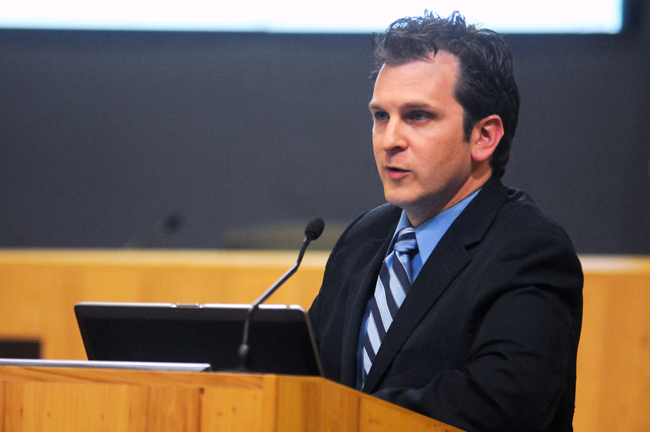Editor’s Note: To the average Longhorn, it may seem like Capital Metro is constantly running late, leaving students steaming and wondering if they’ll get to their destination on time. However, big changes that some stakeholders are confident will resolve those concerns are coming to the system. But all proposals have their detractors, and whether you’ve been paying attention, the new ideas will certainly affect the way you get around town. This week and next, the editorial board will examine these issues, starting with urban rail.
It may have escaped your notice amid the turmoil surrounding President William Powers Jr. and the stress of finals last semester, but December saw the passage of a very important piece of transportation planning that could fundamentally change the mobility landscape of Austin.
Early last month, the Central Corridor Advisory Group approved the development of an urban rail route that will skirt the eastern edge of campus along Red River Street and head from Riverside Drive — a busy and high-need transit corridor — across the river and up to Highland Mall. Tabled in favor of this route was a much more sensible one that would have run from the same southern starting point up Guadalupe Street and North Lamar Boulevard — in other words, on the other side of campus. And if you’ve taken a walk along either route anytime in the past 50 years, you’ll know how the two alignments compare.
For starters, if you’ve ever taken a walk through the no-man’s-land east of campus, you would be lucky to see anyone besides yourself on the sidewalk, whereas, among the hustle and bustle of the Drag, you can’t walk two feet without nearly being knocked over. In other words, the Drag is where it’s at. It’s where people want to be and go, and urban rail should have followed the demand and placed the line where the most people would be encouraged to use it. Sure, it would require some tricky maneuvering to squeeze in the track, especially between 27th and 29th streets, where the road narrows, but that’s not an insurmountable problem and would be offset by the reduction in car traffic.
So why did the planners throw their support behind a route that will one day carry a train through nowhere? Because of the predictions of Project Connect, a partnership between Central Texas transportation agencies that was charged with selecting a route for the new rail line. Put simply, Project Connect expects there to be greater demand along Red River Street in 2030 than will exist on Guadalupe Street and North Lamar Boulevard at the same time.
By what math, though? Even with the new focus on the selected area, it leaves us scratching our heads that the powers-that-be would consider Red River a justifiable route at all.
Dan Keshet, a member of Austinites for Urban Rail Action, crunched the numbers back in November and concluded that Project Connect’s proposal didn’t fit the data. In a blog post, Keshet shined a light on a peculiar criterion. The methodology used by Project Connect could actually rank a corridor that was less congested both today and in 2030 as being in greater need of Cap Metro’s attention if it showed a larger increase in traffic over that time period. In other words, even if the absolute numbers gave the edge to a route with flat, awful traffic, it would fall to the bottom of the ranking just because it didn’t get worse. In the case of the Drag, it might be because traffic simply can’t get much worse. As Keshet put it at the time, “In [Project Connect’s] methodology, two birds in the hand are worth one in the bush.”
What do the city and the mayor’s office, both of which support the Highland route, have to say about that? Well, according to Keshet, very little.
“I have not gotten any real engagement from anybody who disagrees with my analysis,” Keshet told us Wednesday. “I think it’s noteworthy that, when confronted with large public dissatisfaction with the selection that they made, the mayor’s advisory group chose by and large not to engage with the criticisms. Instead, at the last minute, they changed the topic to [Federal Transit Administration] grants, something that had not previously been discussed at any mayor’s advisory meeting, although no new information had been introduced.”
Project Connect was more responsive to us, if you can call it that. Cheyenne Krause, public information specialist at the Austin Transportation Department, defended the organization’s methodology but steered clear of rebutting any of Keshet’s specific claims.
“The Project Connect team stands behind our evaluation during Phase 1 of the Project Connect: Central Corridor High-Capacity Transit Study, and the areas identified for the next high-capacity transit investment, which were endorsed by the Austin City Council in December,” Krause said. “We look forward to working with the community to identify mode, alignment and service alternatives in Phase 2 of the Project Connect: Central Corridor High-Capacity Transit Study, in order to define a Locally Preferred Alternative.”
A locally preferred alternative? How about extending that to the locally preferred route, the one that the most people need at this time? Luckily, the recently approved route is not a foregone conclusion. The route could still be revised — plus, voters will have to OK any proposal before construction can begin. Voters shouldn’t be afraid to use those tools as they consider the options before them.
















